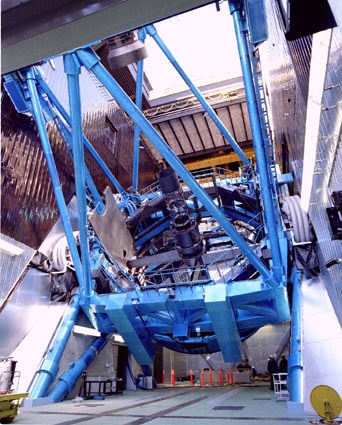Put another checkmark beside the "cold dark matter" theory. New observations by Japan's Subaru Telescope are helping astronomers get a grip on the density of
dark matter
, this mysterious substance that pervades the universe.
We can't see dark matter, which makes up an estimated 85 percent of the universe, but scientists can certainly measure its gravitational effects on galaxies, stars and other celestial residents. Particle physicists also are on the hunt for a "dark matter" particle -- with some
interesting results released a few weeks ago
.
The latest experiment with Subaru measured 50 clusters of galaxies and found that the density of dark matter is largest in the center of these clusters, and smallest on the outskirts. These measurements are a close match to what is predicted by cold dark matter theory, scientists said.
Cold dark matter
assumes that this material can't be observed in any part of the electromagnetic spectrum, the band of light waves that ranges from high-energy X-rays to low-energy infrared heat. Also, the theory dictates that dark matter is made up of slow-moving particles that, because they collide with each other infrequently, are cold. So, the only way dark matter interacts with other particles is by gravity, scientists have said.
To check this out, Subaru peered at
"gravitational lensing
" in the sky -- areas where the light of background objects are bent around dense, massive objects in front.
Galaxy clusters
are a prime example of these super-dense areas.
[caption id="attachment_102904" align="alignnone" width="580"]
Several dark matter maps: one based on a sample of 50 individual galaxy clusters (left), another looking at an average galaxy cluster (center), and another based on dark matter theory (right). Red is the highest concentration of dark matter, followed by yellow, green and blue. At right, in the middle, is a map based on cold dark matter theory that comes close to the average galaxy cluster observed with the Suburu Telescope. Credit: NAOJ/ASIAA/School of Physics and Astronomy, University of Birmingham/Kavli IPMU/Astronomical Institute, Tohoku University)[/caption]
"The Subaru Telescope is a fantastic instrument for gravitational lensing measurements. It allows us to measure very precisely how the dark matter in galaxy clusters distorts light from distant galaxies and gauge tiny changes in the appearance of a huge number of faint galaxies," stated Nobuhiro Okabe, an astronomer at Academia Sinica in Taiwan who led the study.
Next, the team members could compare where the matter was most dense with that predicted by cold dark matter theory. To do that, they measured 50 of the most massive, known clusters of galaxies. Then, they measured the "concentration parameter", or the cluster's average density.
"They found that the density of dark matter increases from the edges to the center of the cluster, and that the concentration parameter of galaxy clusters in the near universe aligns with CDM theory," stated the National Astronomical Observatory of Japan.
The next step, researchers stated, is to measure dark matter density in the center of the galaxy clusters. This could reveal more about how this substance behaves. Check out more about this study in Astrophysical Journal Letters.
Sourcs:
National Astronomical Observatory of Japan
 Universe Today
Universe Today
